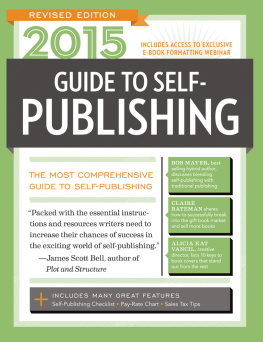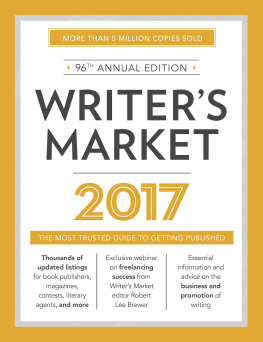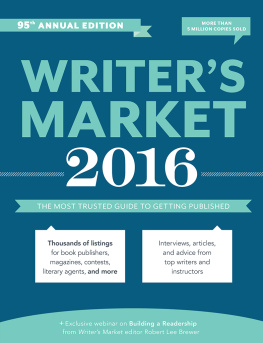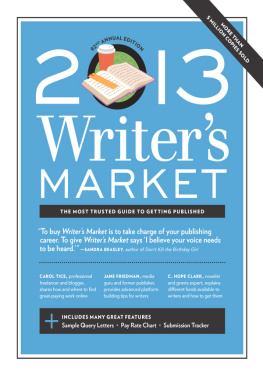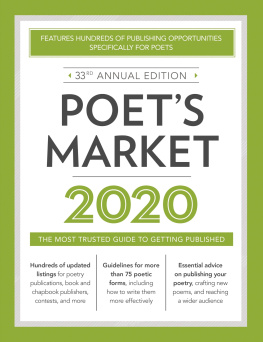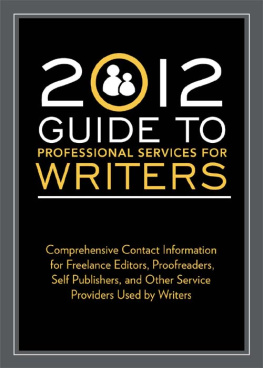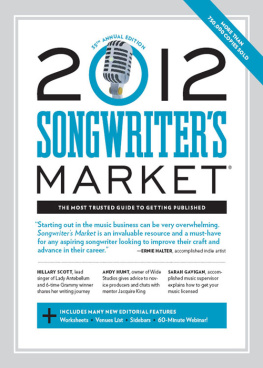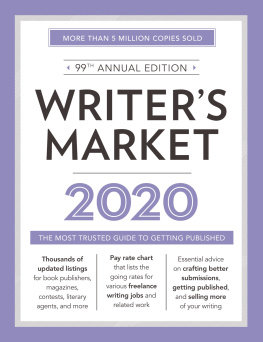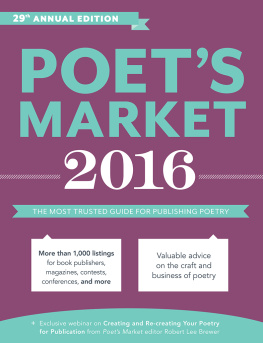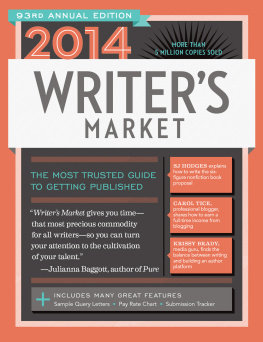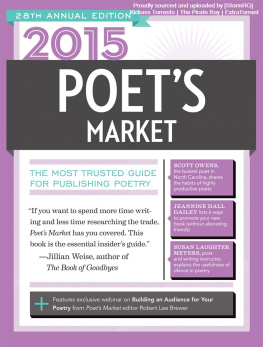REVISED EDITION
2015
GUIDE TO
SELF-PUBLISHING
Robert Lee Brewer, Editor

CONTENTS
by Leslie Lee Sanders
by Peggy DeKay
by Alicia Kat Vancil
by Kit Cooley
by Thursday Bram
by C. Hope Clark
by Carol Topp, CPA
by Aimee Bissonette
by Aaron Belz
by Joanne E. McFadden
by Peggy DeKay
by Sage Cohen
by Carol Topp, CPA
by Robert Lee Brewer
by Dorit Sasson
by Mary Shafer
by Lorena Beniquez
by Dianna Graveman
by Claire Bateman
by Dana Sitar
by Robert Lee Brewer
by Robert Lee Brewer
by Jane Friedman
by Olivia Markham
by S.K. Valenzuela
by Maureen Dillman
by Olivia Markham
FROM THE EDITOR

PHOTO: Al Parrish
When it comes to self-publishing, theres so much writers can (and should) tackle on their own. Its the liberating DIY aspect of self-publishingand higher profit marginsthat draws in so many writer-publishers. But few people are capable of pulling off everything.
For instance, cover design is something most writers might be able to kind of handle, but the cover is often an element of self-publishing in which authors are best served to call in a professional. The words are super important to any book, but the cover is the first impression for readers that can either excite them or temper their expectations.
Before readers can check out your words, they need to feel compelled to crack the spine. Once they do open the book, the words better be top notch. For this reason, all authorseven indie authorsneed editors. In fact, even editors need editors for their own writing.
If youre not receiving free editing and design services already, then this book offers listings for hundreds of freelancers who are ready to help your book have the same polished feel of traditional publishers. Plus, there are articles to help guide indie authors through the design, management, and promotion processesnot to mention interviews with indie authors whove found success with their self-publishing efforts.
You can make this happen and reap the rewards of self-publishing, but it doesnt mean you have to do it all on your own. By enlisting help, youll be able to stay independent and professional at the same time to increase your chances of success.
Speaking of help, access your webinar at www.writersmarket.com/gsp15-webinar.
Until next time, keep publishing!
Robert Lee Brewer
Senior Content Editor, Guide to Self-Publishing
http://blog.writersmarket.com
http://twitter.com/robertleebrewer
PRODUCTION
GETTING STARTED
Guide to Self-Publishing is here to help you navigate the world of self-publishing your work. This article includes information about using this book, but it also covers some of the basics of creating your own books. In fact, this section of the book is labeled Production, because it covers the production of your indie products and services.
Other sections include Management, Promotion, and Interviews. In the Management section, there are articles covering topics like record keeping, self-publishing contracts, pay rates for freelancers you may wish to use, and even handling sales tax. The Promotion section is geared toward reaching your target audience and spreading the gospel about your indie books. Finally, the Interviews section shares stories from indie publishers who have found success self-publishing in a variety of genres.
Beyond the articles, there are plenty of listings for self-publishing companies, freelance editors, freelance designers, independent publicists, and conferences. Each listing section includes an introduction and overview about those specific listings, and the listings include contact information, rates, specialties, and more.
WHERE TO BEGIN
Any project, whether creating books or putting on an event, has to start somewhereand usually thats with an idea. In book publishing, that idea hopefully turns into a manuscript and eventually a book. Thats the simple explanation. Of course, book publishing, whether indie or traditional, is anything but simple.
Heres a better breakdown of what happens:
- Writer gets idea. The idea might start as the line in a poem or scene in a novel. But it starts as a spark, and that spark begins to catch other words and ideas on fire.
- Writer pushes through a first draft. For some writers, this might be a month-long novel writing challenge or years of research on a nonfiction book. It might even be collecting blog content to package and sell. Anyway, the writer gets from beginning to end.
- Writer revises the first draft. Well, writers who are serious about putting out a good product will revise their first drafts. Many books that fail can point to a lack of editing and production value as the main reason the book didnt catch on with readers. In traditional publishing, an editor and agent will work with a writer at this point.
- Writer turns in final draft. In traditional publishing, the writer is now pretty much done with creating the book. However, the indie publisher/writer still has plenty left to do in creating the book.
- Designer lays out book. Fonts are chosen (and licensed in some cases). Front matter, including title and copyright pages, and back matter, including glossaries and indexes, are designed. And dont forget the covers.
- Publisher files a lot of paperwork. Copyright is registered. ISBNs are secured (for print books, digital booksvarious versions). Budgets and marketing plans are set. Records are kept. Eventually, the book is sent to the printer.
- Printer prints books. For indie authors, this might mean sending to printer, or it could mean getting it loaded with a POD company. Also, it could mean loading a compatible electronic file for the digital platform of your choice (Kindle, Nook, iPad, etc.).
- Publisher handles distribution. For the indie publisher, distribution is going to be an uphill battle. But its not impossible. Plus, successful indie publishers are good about getting creative with distribution and finding alternative routes to connecting with their target audience.
- Publisher and writer promote the books. Sometimes, the publisher does more; usually, the writer does more. In indie publishing, theres no question as to who shoulders mostif not allof the work. Thats right, the indie publisher/writer has to roll up her sleeves, make connections, and get her book in front of potential readers.
- Next idea. Successful writers and publishers are never finished with one book. If anything, they feel an even greater urge to figure out the next great idea and successful project. And so, the cycle continues.
KNOW YOUR OPTIONS
Indie publishers have more publishing options than ever. That can be a blessing and a curse. Do writers publish in print or electronic? Print-on-demand (POD) or print run? Local printer or self-publishing company? Writers have a lot of options to weigh.

